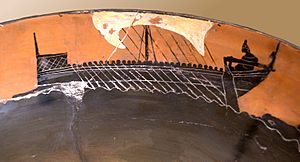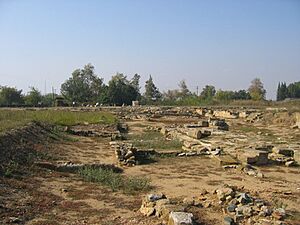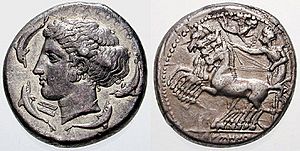Greek colonisation facts for kids
Greek colonization was a big movement of people from ancient Greece. This happened mostly between the 8th and 6th centuries BC. Greeks spread out across the Mediterranean Sea and the Black Sea, setting up new towns.
This expansion was different from earlier movements of people. It was very organized. A leader, called an oikistes, would guide people from their home city, known as the metropolis. Many of these new settlements, called apoikia (which means "home away from home" in Greek), grew into strong, independent Greek city-states. They often became powerful on their own, not relying on their original home city.
Contents
- Why Did Greeks Start New Colonies?
- What Were Greek Colonies Like?
- A Timeline of Greek Colonization
- Where Did the Greeks Settle?
- List of Greek Colonies Before Alexander the Great (Before 336 BC)
- Modern Albania
- Modern Bulgaria
- Modern Croatia
- Modern Cyprus
- Modern Egypt
- Modern France
- Modern Georgia/ Abkhazia
- Modern Greece
- Modern Italy
- Modern Libya
- Modern Montenegro
- Modern North Macedonia
- Modern Palestine (Gaza Strip)
- Modern Romania
- Modern Russia
- Modern Serbia
- Modern Spain
- Modern Syria
- Modern Turkey
- Modern Ukraine
- Images for kids
Why Did Greeks Start New Colonies?
Greeks started new colonies for several important reasons. One big reason was strong economic growth. This led to overpopulation in their home cities. The land in these Greek city-states simply couldn't support everyone.
The places the Greeks chose to colonize were usually very welcoming and had fertile land. This made it easier for the new settlements to grow food and thrive.
What Were Greek Colonies Like?
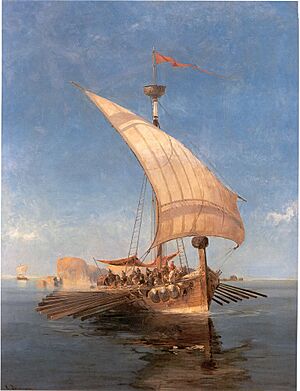
Starting a new colony was always a planned effort by the metropolis (the mother city). Sometimes, different cities even worked together to found a new one. The location for a new colony was chosen carefully. They looked for places that offered good opportunities for trade and were safe from attackers.
To make sure the new colony felt secure, the chosen spot had to be useful. A leader was always chosen by the colonists to guide the mission. In these new cities, the colonists divided up the land, including farms. The way the new cities were governed was usually similar to how the mother city was run.
Many Greek colonies were built along coastlines. This was especially true between the 8th and 6th centuries BC. Being near the coast made it easy to trade, communicate, and use resources from the sea. These coastal colonies helped spread Greek culture, trade networks, and influence across the Mediterranean and Black Sea. While some colonies were built inland, coastal spots were more common because Greeks were very connected to the sea.
A Timeline of Greek Colonization
The Greeks began colonizing around the early 8th century BC. The people from Euboea were among the first. They founded Pithecusae in Southern Italy and Olynthus in Chalcidice, Greece. Later, they also founded cities like Cumae, Zancle, Rhegium, and Naxos.
Towards the end of the 8th century BC, Euboea faced problems, but other Greek groups continued to found colonies. The Ionians and Corinthians were active. Ionians started their first colonies around the 7th century BC in Southern Italy, Thrace, and near the Black Sea. Thera founded Cyrene, and Samos established many colonies in the Northern Aegean Sea.
Where Did the Greeks Settle?
New Cities in Macedonia and Thrace
Many colonies were founded in Northern Greece. Most were in the region of Chalcidice and also in Thrace.
Chalcidice was settled by people from Euboea, especially from Chalcis. They gave their name to these colonies. Important Euboean settlements in Chalcidice included Olynthos, Torone, Mende, and Aphytis. Other key colonies were Acanthus, founded by people from Andros, and Potidaea, a colony of Corinth.
In Thrace, many colonies were founded by Ionians from Asia Minor. Important ones were Maroneia and Abdera. People from Miletus also founded Abydos and Cardia on the Hellespont. The Samians colonized the island of Samothrace, which is how it got its name.
Magna Graecia: Southern Italy and Sicily
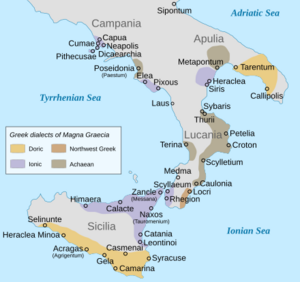
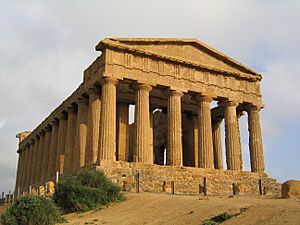
The Romans called the coastal areas of Southern Italy "Magna Graecia," which means "Great Greece." This region, including parts of Calabria, Apulia, Basilicata, Campania, and Sicily, was heavily settled by Greeks.
Greeks started settling in southern Italy in the 8th century BC. The first big wave of settlers went to the Gulf of Naples. After Pithecusae on the island of Ischia, they founded Cumae on the mainland. Then, in the Strait of Messina, they founded Zancle in Sicily and Rhegium on the opposite coast.
Later, people from Achaea focused on the Ionian coast, founding cities like Metapontion and Sybaris. In Sicily, the Euboeans founded Naxos, which became a base for founding other cities like Leontini and Catania. The strongest Sicilian colony was Syracuse, founded by Corinthians in the 8th century BC.
Refugees from Sparta founded Taranto, which became one of the most powerful cities in the area. Many cities in this region then became "mother cities" themselves, founding their own new colonies. For example, Syracusans founded Camarina, and Gela founded Acragas.
Greek culture spread to Italy with these colonies. This included their dialects of the Ancient Greek language, their religious practices, and their traditions of independent city-states. A unique Greek civilization developed there. It later mixed with the local Italic cultures. One very important cultural exchange was the Chalcidean/Cumaean Greek alphabet. The Etruscans adopted it, and it eventually led to the Latin alphabet, which is used widely today.
Ionian Sea, Adriatic Sea, and Illyria
The regions of the Ionian Sea and Illyria were mainly colonized by Corinth. The Corinthians established important colonies along the sea routes to Southern Italy and the west. These colonies helped Corinth become a leading trade center in the western Mediterranean. Key Corinthian colonies included Leucada, Ambracia, and Corcyra in modern-day western Greece.
The Syracusans also founded important colonies in Illyria, which grew into major cities. These included Apollonia and Epidamnus in modern-day Albania. An ancient record describes Epidamnus as a "great power and very populated" city.
Further west, colonists from the Greek city-state Paros founded Pharos on the island of Hvar in the Adriatic in 385 BC. This is where Stari Grad in Croatia is today. In the early 4th century BC, Dionysius I, the ruler of Syracuse, founded the colony Issa on the island of Vis. Traders from Issa then established trading posts in Trogir and Stobreč on the Illyrian mainland.
An ancient Greek inscription found in Lumbarda on the island of Korčula in Croatia talks about another Greek settlement founded there in the 3rd or 4th century BC.
Black Sea and Propontis

Even though the Greeks once called the Black Sea "inhospitable," they eventually founded between 70 and 90 colonies there. The colonization of the Black Sea was led by people from Megara and some Ionian cities like Miletus and Phocaea. Most colonies in the Black Sea and Propontis regions were founded in the 7th century BC.
Early Settlements (Late 7th Century BC)
In the Propontis area, the Megarans founded cities like Chalcedonia and Byzantium, which had a very good location. Miletus founded Cyzicus.
On the western Black Sea coast, the Megarans founded Selymbria and Nesebar. Further north, in modern-day Romania, the Milesians founded Histria and Apollonia.
In the south of the Black Sea, the most important colony was Sinope. It was likely founded by Miletus around the mid-7th century BC. Sinope then founded other colonies in the Pontic region, such as Trebizond and Cerasus.
More Colonies (6th Century BC)
A very important colony founded on the southern Black Sea shore was Heraclea Pontica, established by Megarans and Boeotians in 560-550 BC.
On the north shore of the Black Sea, Miletus started with Pontic Olbia and Panticapaeum (modern Kerch). Around 560 BC, the Milesians founded Odessa in modern Ukraine. On the Crimean peninsula, they founded cities like Nymphaeum and Hermonassa. On the Sea of Azov, they founded Tanais and Phanagoria.
On the eastern shore, known as Colchis (today in Georgia), the Greeks founded Phasis and Dioscouris. The latter is known today as Sukhumi.
Wider Mediterranean Settlements
Greek colonies spread as far as the Iberian Peninsula (modern Spain) and North Africa.
North Africa
In North Africa, on the peninsula of Kyrenaika, colonists from Thera founded Kyrene. This city became very powerful. Other colonies in Kyrenaika included Barca and Euesperides (modern Benghazi).
By the mid-7th century BC, the only Greek colony in Egypt was Naukratis. The pharaoh Psammitecus I allowed Milesian merchants to set up a trading post on the Nile. This post grew into a thriving city. Recent discoveries in Thonis-Heracleion in Egypt suggest that Greeks were settling there even earlier.
Other Mediterranean Areas
On the northern side of the Mediterranean, the Phokaians founded Massalia on the coast of Gaul (modern France). Massalia became a base for founding more cities further away in Spain. Phokaia also founded Alalia in Corsica.
The Phokaians also reached the coast of the Iberian peninsula. A local king invited them to found a colony there and helped them build the city. The Phokaians founded Empuries in this region.
List of Greek Colonies Before Alexander the Great (Before 336 BC)
Here is a list of some Greek colonies, grouped by modern country.
Modern Albania
- Nymphaeum
- Epidamnos
- Apollonia
- Aulon
- Chimara
- Bouthroton
- Oricum
- Thronion
Modern Bulgaria
- Mesembria
- Odessos
- Apollonia / Antheia
- Agathopolis
- Kavarna
- Pomorie
- Naulochos
- Krounoi
- Pistiros
- Anchialos
- Bizone
- Develtos
- Heraclea Sintica
- Beroe
Modern Croatia
- Salona
- Tragyrion
- Aspálathos
- Epidaurus
- Issa
- Dimos
- Pharos
- Kórkyra Mélaina
- Epidaurum
- Narona
- Lumbarda
Modern Cyprus
- Chytri
- Kyrenia
- Golgi
Modern Egypt
- Naucratis
Modern France
- Agde
- Massalia
- Tauroentium/Tauroeis
- Olbia
- Nicaea
- Monoikos
- Antipolis
- Alalia
- Rhodanousia
- Athenopolis
- Pergantium
Modern Georgia/ Abkhazia
- Bathys
- Triglite
- Pityus
- Dioscurias
- Phasis
- Gyenos
Modern Greece
- Potidaea
- Stageira
- Acanthus
- Mende
- Ambracia
- Corcyra
- Maroneia
- Krinides
- Olynthus
- Abdera
- Therma
- Arethusa
- Leucas
- Eion
- Sane
- Amphipolis
- Argilus
- Sane
- Akanthos
- Astacus
- Galepsus
- Oesyme
- Phagres
- Datus
- Stryme
- Pistyrus
- Rhaecelus
- Dicaea
- Methoni
- Heraclea in Trachis
- Heraclea in Acarnania
- Anactorium
- Sale
- Drys
- Toroni
- Amorgos
- Actium
- Scabala
- Philippi
- Colonides
- Oliarus
- Potidaea
- Thera
- Myrcinus
- Tarphe
- Sollium
Modern Italy
- Olbia
- Adria
- Ancona
- Parthenope
- Cumae
- Procida
- Dicaearchia
- Neapolis
- Poseidonia
- Metapontum
- Sybaris
- Thurii
- Taras
- Siris
- Crotona
- Gallipoli
- Elea
- Messina
- Kale Akte
- Syracuse
- Didyme
- Hycesia
- Phoenicusa
- Therassía
- Lipara/Meligounis
- Epizepherean Locris
- Rhegium
- Lentini
- Selinountas
- Megara Hyblaea
- Naxos
- Tauromenium
- Acragas
- Himera
- Gela
- Catania
- Leontini
- Ereikousa
- Euonymos
- Kamarina
- Medma
- Hipponion
- Heraclea Minoa
- Caulonia
- Trotilon
- Pyxous
- Mylae
- Laüs
- Terina
- Rhegion
- Tindari
- Macalla
- Temesa
- Metauros
- Krimisa
- Chone
- Saturo
- Heraclea Lucania, Siris
- Scylletium
- Agathyrnum
- Adranon
- Akrillai
- Casmenae
- Akrai
- Engyon
- Thapsos
- Pithekoussai
- Castelmezzano
- Licata
- Ortygia
- Lagaria
- Hydrus
- Mactorium
- Helorus
Modern Libya
- Barce
- Cyrene
- Balagrae
- Taucheira
- Ptolemais
- Euesperides
- Antipyrgus
- Apollonia
- Cinyps
- Menelai Portus
Modern Montenegro
Modern North Macedonia
- Damastion
- Heraclea Lyncestis
Modern Palestine (Gaza Strip)
- Anthedon (Palestine)
Modern Romania
Modern Russia
- Tanais
- Kepoi
- Phanagoria
- Bata
- Gorgippia
- Hermonassa
- Korokondame
- Taganrog
- Tyramba
- Patraeus
- Toricos
Modern Serbia
- Damastion
Modern Spain
- Portus Illicitanus
- Akra Leuke
- Alonis
- Hemeroscopeum
- Zakynthos
- Salauris
- Rhode
- Emporion
- Kalathousa
- Mainake
- Menestheus's Limin
- Kypsela
- Helike
Modern Syria
- Posidium
Modern Turkey
- Selymbria
- Heraclea Pontica
- Cius
- Ephesus
- Dios Hieron
- Iasos
- Myndus
- Selge
- Priene
- Halicarnassus
- Miletus
- Tralles
- Phaselis
- Aspendos
- Side
- Sillyon
- Zephyrion
- Kelenderis
- Mallus
- Amos
- Byzantium
- Amaseia
- Amastris
- Ainos
- Berge
- Perinthos
- Cardia
- Chalcedon
- Nicomedia
- Abydos
- Sestos
- Lampsacus
- Panormos
- Cyzicus
- Ilion
- Sigeion
- Sinope
- Tirebolu
- Amisos
- Tripolis
- Cotyora
- Polemonion
- Pharnakia
- Kerasous
- Trapezous
- Themiscyra
- Astacus in Bithynia
- Assos
- Pitane
- Phocaea
- Smyrna
- Pergamon
- Teos
- Colophon
- Patara
- Canae
- Bargylia
- Madytus
- Elaeus
- Tieion
- Apamea Myrlea
- Klazomenai
- Notion
- Parion
- Heraion Teichos
- Bisanthe
- Erythrae
- Priapus
- Alopeconnesus
- Limnae
- Crithote
- Pactya
- Perinthus
- Tium
- Teichiussa
- Triopium
- Placia
- Scylace
- Arisba
- Apollonia
- Apollonia ad Rhyndacum
- Myrina
- Pythopolis
- Cytorus
- Armene
- Kolonai
- Paesus
- Scepsis
- Myus
- Mallus
- Mopsus
- Caryanda
- Athenae
- Syrna
- Cyme
- Marathesium
- Chrysopolis
- Neonteichos
- Artace
- Semystra
- Cobrys
- Cypasis
- Kydonies
- Coryphas
- Heraclea (Aeolis)
- Gargara
- Lamponeia
- Elaea
- Mariandyn
- Claros
- Knidos
- Prusias ad Hypium
- Dardanus
- Pygela
- Temnos
- Gryneium
- Aigai
- Rhoiteion
- Cadrema
- Daminon Teichos
- Hydrela
- Athymbra
- Carussa
- Termera
- Hamaxitus
Modern Ukraine
- Borysthenes
- Tyras
- Olbia
- Nikonion
- Odessa
- Panticapaeum
- Nymphaion
- Tyritake
- Theodosia
- Chersonesus
- Charax
- Myrmekion
- Kerkinitis
- Yalita
- Akra
- Manitra
- Gelonus
Images for kids
-
Greek colonies of the Mediterranean Sea and Black Sea and their metropolitan cities depicted with red labels, while Phoenician colonies are depicted with yellow labels



